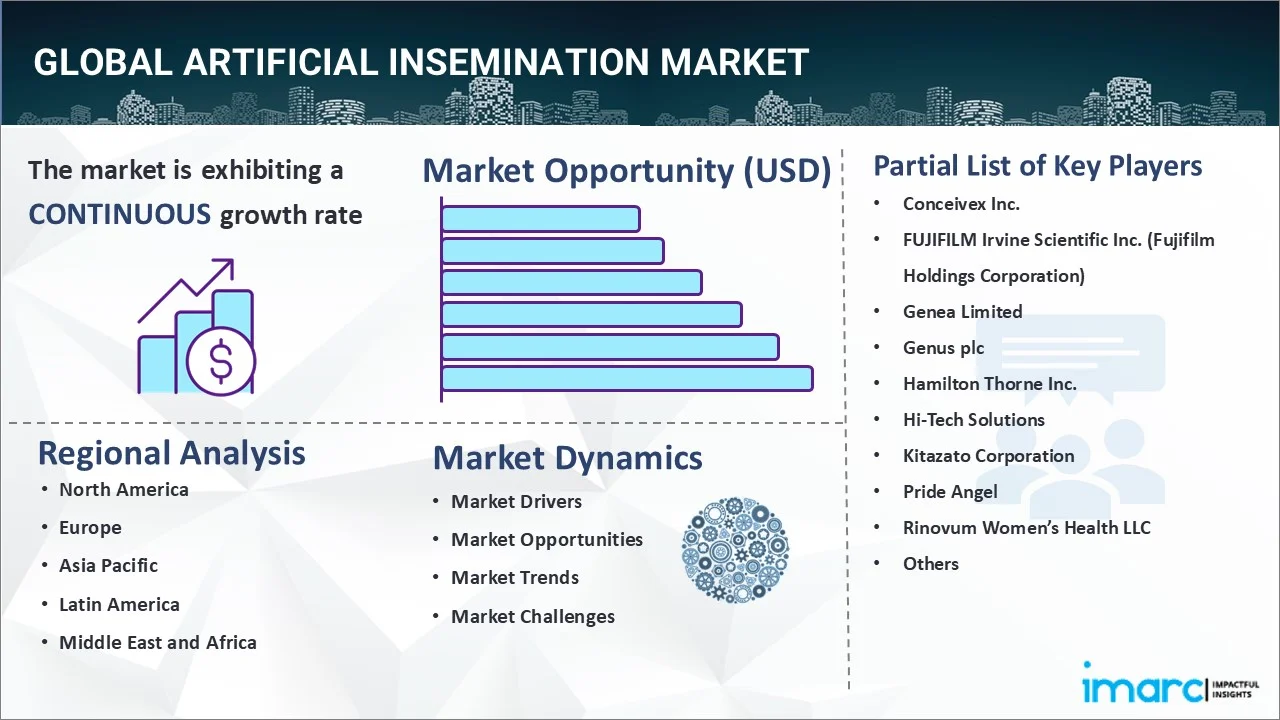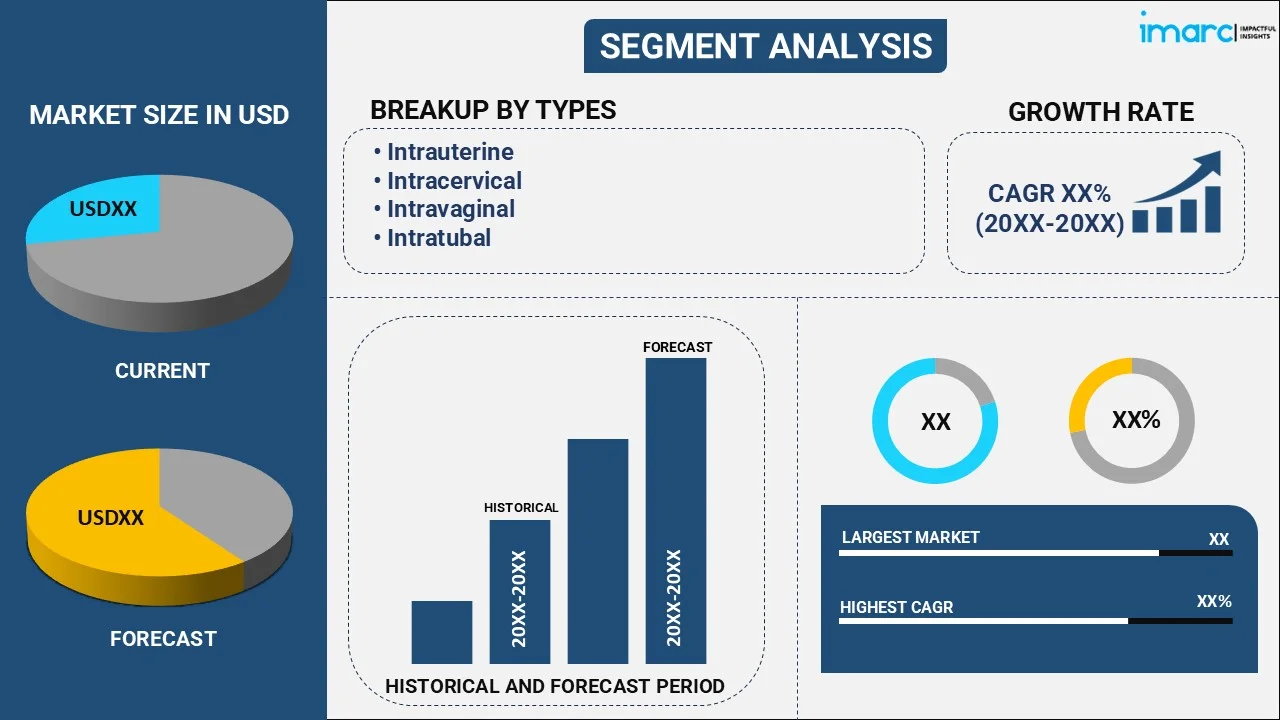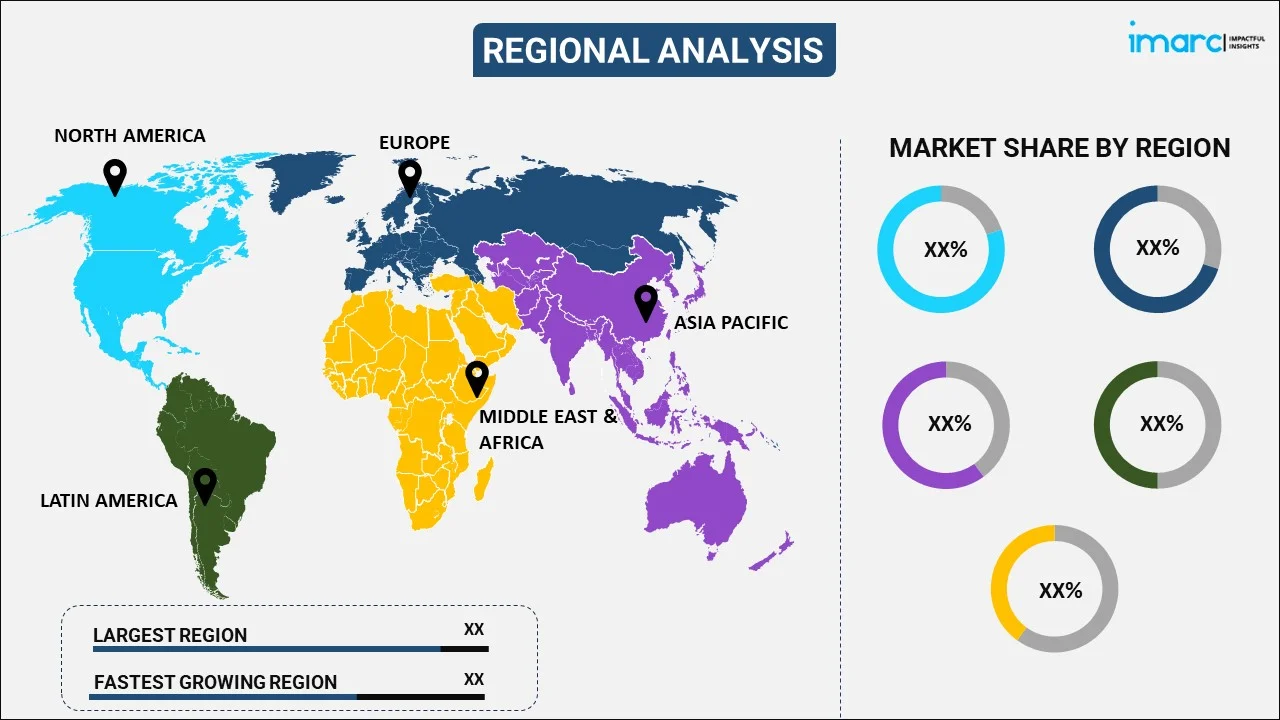
Artificial Insemination Market Report by Type (Intrauterine, Intracervical, Intravaginal, Intratubal), Source Type (AIH-Husband, AID-Donor), End Use (Hospitals and Clinics, Fertility Centers, and Others), and Region 2025-2033
Global Artificial Insemination Market:
The global artificial insemination market size reached USD 2.3 Billion in 2024. Looking forward, IMARC Group expects the market to reach USD 4.6 Billion by 2033, exhibiting a growth rate (CAGR) of 7.15% during 2025-2033. Increasing infertility rates, rapid lifestyle changes, and escalating prevalence of medical conditions represent some of the key factors driving the market demand.
|
Report Attribute
|
Key Statistics
|
|---|---|
|
Base Year
|
2024
|
|
Forecast Years
|
2025-2033
|
|
Historical Years
|
2019-2024
|
|
Market Size in 2024
|
USD 2.3 Billion |
|
Market Forecast in 2033
|
USD 4.6 Billion |
| Market Growth Rate 2025-2033 | 7.15% |
Artificial Insemination Market Analysis:
- Major Market Drivers: The increasing infertility rates and the need for assisted reproductive technologies (ART) are some of the key factors boosting the market growth. The rapid lifestyle changes and escalating prevalence of medical conditions, such as polycystic ovary syndrome (PCOS) and endometriosis, have surged the demand for artificial insemination procedures, further accelerating the artificial insemination market demand.
- Key Market Trends: Various technological advancements, such as the development of improved techniques for sperm and egg selection, cryopreservation, and pre-implantation genetic testing, are propelling the market growth. Besides this, the increasing availability of donor sperm and donor eggs, the rising popularity of same-sex marriage and LGBT parenting, and the improving healthcare infrastructure, are some of the factors expected to drive the artificial insemination market growth.
- Competitive Landscape: Some of the prominent artificial insemination market companies include Conceivex Inc., FUJIFILM Irvine Scientific Inc. (Fujifilm Holdings Corporation), Genea Limited, Genus plc, Hamilton Thorne Inc., Hi-Tech Solutions, Kitazato Corporation, Pride Angel, Rinovum Women’s Health LLC, Rocket Medical plc, TenderNeeds Fertility LLC, and Vitrolife AB, among many others.
- Geographical Trends: According to the artificial insemination market dynamics, North America dominates the overall market. The increasing infertility rates among men and women due to factors like lifestyle changes, delayed pregnancies, obesity, stress, and exposure to environmental toxins are major drivers of the artificial insemination market in North America.
- Challenges and Opportunities: The high cost of treatment and shortage of high-quality sperm and egg donors are hampering the market's growth. However, as fertility issues become more widespread, driven by factors like rising maternal age and environmental factors, the demand for artificial insemination and other ART procedures continues to grow, creating expansion opportunities for fertility clinics.

Artificial Insemination Market Trends:
Rising Demand for Healthy Foods
There has been a significant increase in the infertility rates. For instance, according to the World Health Organization (WHO), infertility affects approximately 17.5% of the adult population or roughly one in every six people in the world. Also, according to another article published by Sigle Care, in developing nations, one in every four couples suffers from infertility. The rising infertility rates among both men and women, due to factors such as lifestyle changes, increasing stress, pollution, obesity, and delayed family planning, have contributed to higher demand for fertility treatments, including artificial insemination. These factors are expected to propel the artificial insemination market share in the coming years.
Increasing Utilization in the Animal Breeding Sector
The use of artificial insemination in the animal breeding sector, particularly in livestock and dairy farming, is a key market driver. For instance, according to an article published by the Food and Agriculture Organization, based on total cattle and buffalo populations, it is estimated that approximately 30% are artificially inseminated in Europe, North America, Australia, New Zealand, and Japan, and the corresponding proportion for the rest of the world is around 4%. AI in animals helps improve genetic quality, enhance productivity, and increase efficiency in breeding programs, contributing to the overall growth of the AI market. These factors further positively influence the artificial insemination market forecast.
Expanding Fertility Services
The increasing availability of specialized fertility clinics equipped with advanced technologies and trained professionals is driving the market. More fertility centers offering services like artificial insemination are opening, particularly in urban areas and developed regions, making these treatments more accessible. For instance, in April 2023, Marubeni Corporation and TOWAKO REPRO BIO CELL INC., which operates an IVF clinic in the Republic of the Philippines, formed a joint venture in the country's IVF-related business by investing in Conceive IVF Manila Inc., which runs an IVF diagnostic center. For the Project, CIMI will work with Kato Ladies Clinic. This project will enhance the functions of CIMI and transform it from an IVF diagnostic center to a full IVF clinic, delivering comprehensive IVF-related services such as infertility work-up (cycle tracking and artificial insemination), thereby boosting the artificial insemination market revenue.
Global Artificial Insemination Industry Segmentation:
IMARC Group provides an analysis of the key trends in each sub-segment of the market, along with the artificial insemination market forecasts at the global, regional, and country levels from 2025-2033. Our report has categorized the market based on type, source type, and end use.
Breakup by Type:

- Intrauterine
- Intracervical
- Intravaginal
- Intratubal
The intrauterine segment dominates the market
The report has provided a detailed breakup and analysis of the global artificial insemination market based on the type. This includes intrauterine, intracervical, intravaginal, and intratubal. According to the report, the intrauterine segment dominates the market.
According to the artificial insemination market outlook, intrauterine insemination involves placing sperm directly into the uterus, increasing the chances of sperm reaching the egg for fertilization. IUI generally offers higher success rates, particularly when dealing with male infertility factors such as low sperm motility. This makes it a preferred option for many patients.
Breakup by Source Type:
- AIH-Husband
- AID-Donor
The report has provided a detailed breakup and analysis of the global artificial insemination market based on the source type. This includes AIH-husband and AID-donor.
According to the artificial insemination market outlook report, AIH involves using the husband's (or male partner’s) sperm for insemination, often after sperm preparation to optimize chances of fertilization. One of the primary drivers of AIH is male factor infertility, which can involve low sperm count, poor sperm motility, or abnormal sperm morphology. AIH is often used when the sperm is viable but needs to be concentrated or processed for better chances of fertilization. Moreover, AID involves using donor sperm, typically from a sperm bank, to inseminate the woman. This is often done when the male partner’s sperm is not viable or in cases where the woman is single or in a same-sex relationship.
Breakup by End Use:
- Hospitals and Clinics
- Fertility Centers
- Others
The fertility centers segment spearheads the market
The report has provided a detailed breakup and analysis of the global artificial insemination market based on the end use. This includes hospitals and clinics, fertility centers, and others. According to the report, the fertility centers segment spearheads the market.
According to the artificial insemination market forecast report, the demand for Artificial Insemination (AI) in fertility centers is driven by a combination of medical, technological, demographic, and social factors. Fertility centers play a critical role in providing specialized reproductive services, and they are at the forefront of delivering assisted reproductive technologies (ART) such as intrauterine insemination (IUI), intracervical insemination (ICI), and other AI procedures.
Breakup by Region:

- North America
- United States
- Canada
- Asia-Pacific
- China
- Japan
- India
- South Korea
- Australia
- Indonesia
- Others
- Europe
- Germany
- France
- United Kingdom
- Italy
- Spain
- Russia
- Others
- Latin America
- Brazil
- Mexico
- Others
- Middle East and Africa
North America dominates the market
The report has also provided a comprehensive analysis of all the major regional markets, which include North America (the United States and Canada); Europe (Germany, France, the United Kingdom, Italy, Spain, Russia, and others); Asia Pacific (China, Japan, India, South Korea, Australia, Indonesia, and others); Latin America (Brazil, Mexico, and others); and the Middle East and Africa. According to the report, North America dominates the market.
According to the artificial insemination market statistics, some of the factors accelerating the North America artificial insemination market include the surging awareness regarding the advantages of artificial insemination, the rising consumer per capita expenditure, and burgeoning healthcare expenditure. The rising infertility rates among both men and women, driven by lifestyle changes, stress, pollution, delayed childbearing, and certain medical conditions, are a major driver of the AI market. Infertility rates have steadily increased in the region, with many couples and individuals turning to artificial insemination as a solution. Moreover, in North America, many women are choosing to delay parenthood due to career, financial, or personal reasons. For instance, according to an article published by Forbes, over the last decade, as more women of all social groups have emphasized education and profession, deferring motherhood has become practically universal among American women. As maternal age increases, fertility declines, leading to more individuals seeking assisted reproductive technologies (ART), including artificial insemination, to conceive. According to the artificial insemination market research, this is augmenting the regional market.
Competitive Landscape:
The artificial insemination market research report has provided a comprehensive analysis of the competitive landscape. Detailed profiles of all major market companies have also been provided. Some of the key players in the market include:
- Conceivex Inc.
- FUJIFILM Irvine Scientific Inc. (Fujifilm Holdings Corporation)
- Genea Limited
- Genus plc
- Hamilton Thorne Inc.
- Hi-Tech Solutions
- Kitazato Corporation
- Pride Angel
- Rinovum Women’s Health LLC
- Rocket Medical plc
- TenderNeeds Fertility LLC
- Vitrolife AB
(Please note that this is only a partial list of the key players, and the complete list is provided in the report.)
Artificial Insemination Market Recent Developments:
- September 2024: LUPANE State University (LSU) offered an artificial insemination program to help farmers improve the quality of their goats. The effort aims to reduce the number of farmers who spend large sums of money on Boer and Kalahari Desert bucks to help their herds develop.
- September 2024: The Punjab animal husbandry department set an annual target of 30 lakh artificial inseminations across the state.
- August 2024: Aetna®, a CVS Health® Company, included intrauterine insemination (IUI) as a medical benefit in qualified plans. Members may use this benefit to test their fertility and, in some situations, boost their chances of becoming pregnant.
Artificial Insemination Market Report Scope:
| Report Features | Details |
|---|---|
| Base Year of the Analysis | 2024 |
| Historical Period | 2019-2024 |
| Forecast Period | 2025-2033 |
| Units | Billion USD |
| Scope of the Report | Exploration of Historical Trends and Market Outlook, Industry Catalysts and Challenges, Segment-Wise Historical and Future Market Assessment:
|
| Types Covered | Intrauterine, Intracervical, Intravaginal, Intratubal |
| Source Types Covered | AIH-Husband, AID-Donor |
| End Uses Covered | Hospitals and Clinics, Fertility Centers, Others |
| Regions Covered | Asia Pacific, Europe, North America, Latin America, Middle East and Africa |
| Countries Covered | United States, Canada, Germany, France, United Kingdom, Italy, Spain, Russia, China, Japan, India, South Korea, Australia, Indonesia, Brazil, Mexico |
| Companies Covered | Conceivex Inc., FUJIFILM Irvine Scientific Inc. (Fujifilm Holdings Corporation), Genea Limited, Genus plc, Hamilton Thorne Inc., Hi-Tech Solutions, Kitazato Corporation, Pride Angel, Rinovum Women’s Health LLC, Rocket Medical plc, TenderNeeds Fertility LLC, Vitrolife AB, etc. |
| Customization Scope | 10% Free Customization |
| Post-Sale Analyst Support | 10-12 Weeks |
| Delivery Format | PDF and Excel through Email (We can also provide the editable version of the report in PPT/Word format on special request) |
Key Benefits for Stakeholders:
- IMARC's report offers a comprehensive quantitative analysis of various market segments, historical and current market trends, market forecasts, and dynamics of the artificial insemination market from 2019-2033.
- The research study provides the latest information on the market drivers, challenges, and opportunities in the global artificial insemination market.
- The study maps the leading, as well as the fastest-growing, regional markets. It further enables stakeholders to identify the key country-level markets within each region.
- Porter's five forces analysis assists stakeholders in assessing the impact of new entrants, competitive rivalry, supplier power, buyer power, and the threat of substitution. It helps stakeholders to analyze the level of competition within the artificial insemination industry and its attractiveness.
- The competitive landscape allows stakeholders to understand their competitive environment and provides insight into the current positions of key players in the market.
Key Questions Answered in This Report
The global artificial insemination market was valued at USD 2.3 Billion in 2024.
We expect the global artificial insemination market to exhibit a CAGR of 7.15% during 2025-2033.
The rising infertility rates, along with the introduction of improved techniques for sperm and egg selection, cryopreservation, and pre-implantation genetic testing, are primarily driving the global artificial insemination market.
The sudden outbreak of the COVID-19 pandemic had led to the postponement of elective artificial insemination surgical procedures to reduce the risk of the coronavirus infection upon hospital visits and interaction with healthcare professionals or medical equipment.
Based on the type, the global artificial insemination market has been segregated into intrauterine, intracervical, intravaginal, and intratubal. Among these, intrauterine currently holds the largest market share.
Based on the end use, the global artificial insemination market can be bifurcated into hospitals and clinics, fertility centers, and others. Currently, fertility centers exhibit a clear dominance in the market.
On a regional level, the market has been classified into North America, Asia-Pacific, Europe, Latin America, and Middle East and Africa, where North America currently dominates the global market.
Some of the major players in the global artificial insemination market include Conceivex Inc., FUJIFILM Irvine Scientific Inc. (Fujifilm Holdings Corporation), Genea Limited, Genus plc, Hamilton Thorne Inc., Hi-Tech Solutions, Kitazato Corporation, Pride Angel, Rinovum Women’s Health LLC, Rocket Medical plc, TenderNeeds Fertility LLC, Vitrolife AB, etc.
Need more help?
- Speak to our experienced analysts for insights on the current market scenarios.
- Include additional segments and countries to customize the report as per your requirement.
- Gain an unparalleled competitive advantage in your domain by understanding how to utilize the report and positively impacting your operations and revenue.
- For further assistance, please connect with our analysts.
 Inquire Before Buying
Inquire Before Buying
 Speak to an Analyst
Speak to an Analyst
 Request Brochure
Request Brochure
 Request Customization
Request Customization




.webp)




.webp)












